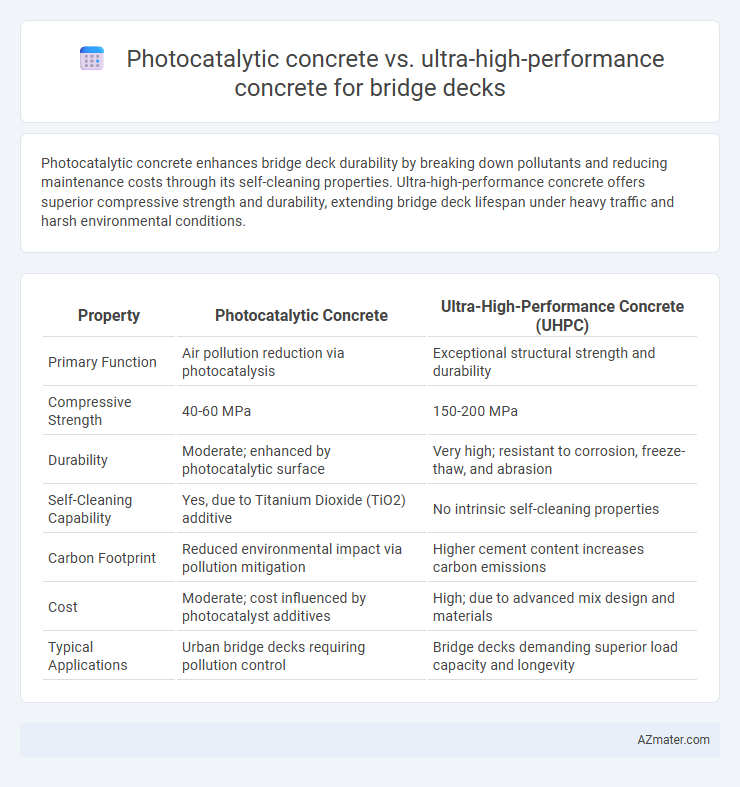Photocatalytic concrete enhances bridge deck durability by breaking down pollutants and reducing maintenance costs through its self-cleaning properties. Ultra-high-performance concrete offers superior compressive strength and durability, extending bridge deck lifespan under heavy traffic and harsh environmental conditions.
Table of Comparison
| Property | Photocatalytic Concrete | Ultra-High-Performance Concrete (UHPC) |
|---|---|---|
| Primary Function | Air pollution reduction via photocatalysis | Exceptional structural strength and durability |
| Compressive Strength | 40-60 MPa | 150-200 MPa |
| Durability | Moderate; enhanced by photocatalytic surface | Very high; resistant to corrosion, freeze-thaw, and abrasion |
| Self-Cleaning Capability | Yes, due to Titanium Dioxide (TiO2) additive | No intrinsic self-cleaning properties |
| Carbon Footprint | Reduced environmental impact via pollution mitigation | Higher cement content increases carbon emissions |
| Cost | Moderate; cost influenced by photocatalyst additives | High; due to advanced mix design and materials |
| Typical Applications | Urban bridge decks requiring pollution control | Bridge decks demanding superior load capacity and longevity |
Introduction to Advanced Concrete Technologies for Bridge Decks
Photocatalytic concrete incorporates titanium dioxide to enhance air purification and self-cleaning properties, making it an innovative solution for bridge decks exposed to urban pollution. Ultra-high-performance concrete (UHPC) provides exceptional mechanical strength, durability, and resistance to environmental stressors, ideal for extending the lifespan of bridge decks under heavy traffic loads. Both advanced materials address the challenges of sustainability and maintenance in bridge construction, with photocatalytic concrete focusing on environmental benefits and UHPC prioritizing structural performance.
Overview of Photocatalytic Concrete
Photocatalytic concrete incorporates titanium dioxide nanoparticles, enabling it to break down air pollutants such as nitrogen oxides through a light-activated chemical reaction, enhancing environmental quality near bridge decks. This self-cleaning and pollution-reducing capability distinguishes photocatalytic concrete from conventional materials, contributing to improved durability and reduced maintenance costs. Its photocatalytic efficiency depends on factors like titanium dioxide concentration, concrete porosity, and exposure to sunlight, making it a sustainable choice for urban bridge deck applications.
Advantages of Photocatalytic Concrete in Bridge Applications
Photocatalytic concrete offers significant advantages in bridge deck applications due to its self-cleaning and air-purifying properties, enabled by the titanium dioxide (TiO2) catalyst that reduces surface pollutants and organic contaminants. This innovative concrete improves durability by decreasing dirt accumulation and mitigating corrosion, which enhances structural longevity and reduces maintenance costs. Its ability to break down harmful nitrogen oxides (NOx) contributes to improved environmental quality around bridge areas, making it a sustainable choice compared to ultra-high-performance concrete.
Overview of Ultra-High-Performance Concrete (UHPC)
Ultra-High-Performance Concrete (UHPC) exhibits exceptional compressive strength exceeding 150 MPa and enhanced durability, making it ideal for bridge decks subjected to heavy loads and harsh environmental conditions. Its dense microstructure and optimized particle packing significantly reduce permeability, improving resistance to chloride ingress and freeze-thaw cycles. UHPC's high tensile strength and ductility contribute to longer service life and reduced maintenance costs compared to conventional concretes, including photocatalytic variants.
Benefits of UHPC for Bridge Deck Construction
Ultra-high-performance concrete (UHPC) offers exceptional compressive strength exceeding 150 MPa and superior durability, making it ideal for bridge deck applications where longevity and load resistance are critical. Its dense microstructure significantly reduces permeability, enhancing resistance to chloride ingress and freeze-thaw cycles, which mitigates corrosion of embedded reinforcement. UHPC enables thinner, lighter bridge decks that reduce overall structural weight and maintenance costs while providing enhanced fatigue resistance under heavy traffic loads.
Comparative Durability: Photocatalytic Concrete vs. UHPC
Photocatalytic concrete offers self-cleaning properties and enhanced resistance to surface pollutants, reducing maintenance needs for bridge decks. Ultra-high-performance concrete (UHPC) provides superior mechanical strength, low permeability, and exceptional durability against freeze-thaw cycles and chloride ingress, significantly extending service life. Comparative durability studies indicate UHPC outperforms photocatalytic concrete in load-bearing capacity and long-term structural resilience, while photocatalytic concrete excels in environmental maintenance and superficial contamination resistance.
Environmental Impact and Sustainability Considerations
Photocatalytic concrete enhances environmental sustainability by reducing air pollutants through photocatalysis, breaking down nitrogen oxides and volatile organic compounds on the bridge deck surface. Ultra-high-performance concrete (UHPC) offers superior durability and longevity, reducing maintenance frequency and material consumption over time, thus minimizing the environmental footprint. Both materials contribute to sustainable infrastructure; however, photocatalytic concrete addresses air quality improvement while UHPC emphasizes structural resilience and lifecycle efficiency.
Cost Analysis and Lifecycle Performance
Photocatalytic concrete offers reduced maintenance costs by breaking down pollutants and preventing surface degradation, which enhances the lifespan of bridge decks. Ultra-high-performance concrete (UHPC) delivers superior mechanical properties and durability, leading to lower lifecycle costs through minimized repair frequency despite its higher initial material expenses. When evaluating cost analysis and lifecycle performance, UHPC's long-term strength and resistance to environmental stressors often justify its upfront investment, whereas photocatalytic concrete provides environmental benefits and moderate cost savings in maintenance.
Case Studies: Real-World Applications and Outcomes
Case studies highlight photocatalytic concrete's effectiveness in reducing air pollution and maintaining cleaner bridge decks through titanium dioxide's ability to break down pollutants, as demonstrated in Japan's Shuto Expressway. Ultra-high-performance concrete (UHPC) exhibits superior durability and load-bearing capacity, proven by its use in the Quebec Bridge, which extended deck lifespan by mitigating cracking and corrosion. Real-world applications reveal photocatalytic concrete's environmental benefits complement UHPC's structural advantages, offering tailored solutions for sustainable and resilient bridge deck construction.
Conclusion: Choosing the Right Concrete Technology for Bridge Decks
Photocatalytic concrete offers self-cleaning and pollution-reducing benefits, enhancing urban air quality and reducing maintenance costs for bridge decks. Ultra-high-performance concrete (UHPC) provides superior strength, durability, and resistance to environmental stress, extending the lifespan and load capacity of bridge structures. Selecting the right concrete technology depends on prioritizing either environmental impact and maintenance efficiency with photocatalytic concrete or structural performance and longevity with UHPC for bridge deck applications.

Infographic: Photocatalytic concrete vs Ultra-high-performance concrete for Bridge deck
 azmater.com
azmater.com